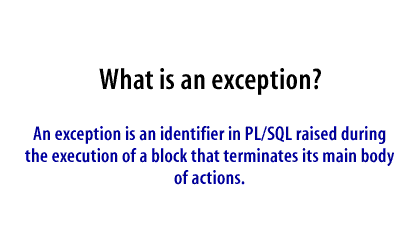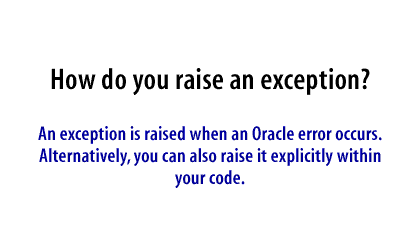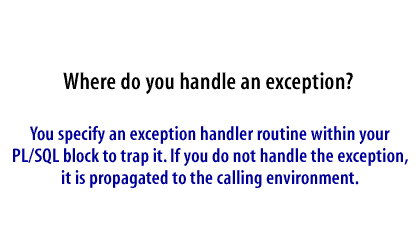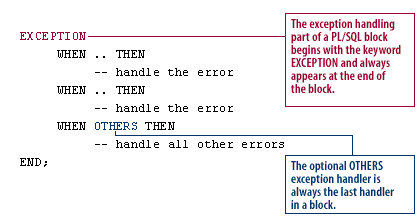| Lesson 2 | What is an exception and why trap it? |
| Objective | Define an exception and its purpose. |
What is PL/SQL Exception
Runtime errors can arise from design faults, coding mistakes, hardware
failures, and several other sources. Certain kinds of errors can be handled via a PL/SQL block. In PL/SQL, an error condition is called an exception.
Exceptions can be either internally defined or user defined. An exception is declared within the declarative part of a PL/SQL block by naming the exception and defining it as a datatype of EXCEPTION. Unlike internal exceptions, user-defined exceptions must be given names.
When an error occurs, an exception is raised whereby normal execution stops and the control is transferred to the exception handling routine of the PL/SQL block. Internal exceptions are raised automatically by the runtime system, whereas user-defined exceptions are raised explicitly by the
Use the following Slide Show to learn more about the use of exceptions within PL/SQL.
When an error occurs, an exception is raised whereby normal execution stops and the control is transferred to the exception handling routine of the PL/SQL block. Internal exceptions are raised automatically by the runtime system, whereas user-defined exceptions are raised explicitly by the
RAISE statement.Use the following Slide Show to learn more about the use of exceptions within PL/SQL.



Handling raised Exceptions
To handle raised exceptions, separate routines called exception handlers are written. When an exception handler is invoked, the current block stops executing and the enclosing block resumes with the next statement. If there is no enclosing block, control returns to the host environment.
You already learned about the host environment in an earlier module.

OTHERS hander
The optional
Use of the
OTHERS exception handler acts as the handler for all exceptions that the block does not name specifically.
Thus, a block can have only one OTHERS hander. Use of the
OTHERS handler guarantees that no exception will go unhandled. If two or more exceptions should be executed in the same sequence of statements, list the exception names within the WHEN clause, separating them by the keyword OR,
as shown in the following example:
EXCEPTION WHEN over_limit OR under_limit OR VALUE_ERROR THEN -- handle the error WHEN OTHERS THEN -- handle all other errors END;
If any of the exceptions in the above list is raised, PL/SQL executes the associated sequence of statements. The keyword
THERS is not allowed in such a list of exception names; it must appear by itself.
Guidelines for handling Exceptions
Here are some of the guidelines you want to keep in mind when developing exception handling routines:
- There can be any number of exception handlers.
- Each handler can associate a sequence of statements with a list of exceptions.
- An exception name can appear only once within the exception handling part of a block.
- Only one exception can be active at a time within the exception handling part of a block.
- If an exception is raised inside a handler, the block that encloses the current block is the first block searched to find a handler for the newly raised exception. From there on, the exception propagates normally.